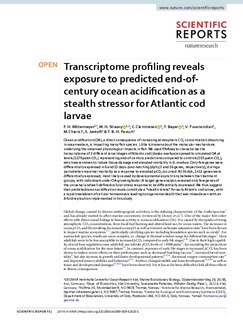Transcriptome profiling reveals exposure to predicted end-of-century ocean acidification as a stealth stressor for Atlantic cod larvae
| dc.contributor.author | Mittermayer, Felix H. | |
| dc.contributor.author | Stiasny, Martina H. | |
| dc.contributor.author | Clemmesen, Catriona M. | |
| dc.contributor.author | Bayer, Till | |
| dc.contributor.author | Puvanendran, Velmurugu | |
| dc.contributor.author | Chierici, Melissa | |
| dc.contributor.author | Jentoft, Sissel | |
| dc.contributor.author | Reusch, Thorsten B.H. | |
| dc.date.accessioned | 2020-01-10T07:57:43Z | |
| dc.date.available | 2020-01-10T07:57:43Z | |
| dc.date.created | 2019-12-23T14:40:54Z | |
| dc.date.issued | 2019 | |
| dc.identifier.citation | Scientific Reports. 2019, 9:16908 (1), 1-11. | nb_NO |
| dc.identifier.issn | 2045-2322 | |
| dc.identifier.uri | http://hdl.handle.net/11250/2635596 | |
| dc.description.abstract | Ocean acidification (OA), a direct consequence of increasing atmospheric CO2 concentration dissolving in ocean waters, is impacting many fish species. Little is known about the molecular mechanisms underlying the observed physiological impacts in fish. We used RNAseq to characterize the transcriptome of 3 different larval stages of Atlantic cod (Gadus morhua) exposed to simulated OA at levels (1179 µatm CO2) representing end-of-century predictions compared to controls (503 µatm CO2), which were shown to induce tissue damage and elevated mortality in G. morhua. Only few genes were differentially expressed in 6 and 13 days-post-hatching (dph) (3 and 16 genes, respectively), during a period when maximal mortality as a response to elevated pCO2 occurred. At 36 dph, 1413 genes were differentially expressed, most likely caused by developmental asynchrony between the treatment groups, with individuals under OA growing faster. A target gene analysis revealed only few genes of the universal and well-defined cellular stress response to be differentially expressed. We thus suggest that predicted ocean acidification levels constitute a “stealth stress” for early Atlantic cod larvae, with a rapid breakdown of cellular homeostasis leading to organismal death that was missed even with an 8-fold replication implemented in this study. | nb_NO |
| dc.language.iso | eng | nb_NO |
| dc.title | Transcriptome profiling reveals exposure to predicted end-of-century ocean acidification as a stealth stressor for Atlantic cod larvae | nb_NO |
| dc.type | Journal article | nb_NO |
| dc.type | Peer reviewed | nb_NO |
| dc.description.version | publishedVersion | nb_NO |
| dc.source.pagenumber | 1-11 | nb_NO |
| dc.source.volume | 9:16908 | nb_NO |
| dc.source.journal | Scientific Reports | nb_NO |
| dc.source.issue | 1 | nb_NO |
| dc.identifier.doi | 10.1038/s41598-019-52628-1 | |
| dc.identifier.cristin | 1763770 | |
| cristin.unitcode | 7431,20,0,0 | |
| cristin.unitname | Oseanografi og klima | |
| cristin.ispublished | true | |
| cristin.fulltext | original | |
| cristin.qualitycode | 1 |
Tilhørende fil(er)
Denne innførselen finnes i følgende samling(er)
-
Articles [3011]
-
Publikasjoner fra CRIStin [3061]
